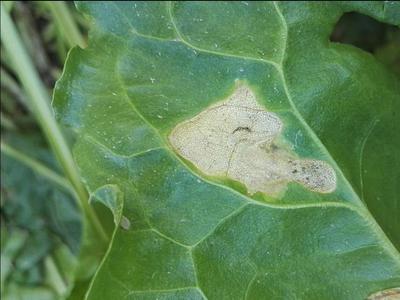
Micosis/Hongos
Ramularia
Ramularia Betícola
Pathogen:
Fungus
Type:
Risk to the plant:
HIGH



DESCRIPTION
WHO CAUSES IT?
Ramularia betícola is a phytopathogenic fungus that mainly affects beets. This fungus produces conidial spores that are spread through wind, water, and contaminated tools. Spore germination occurs under conditions of high humidity and moderate temperatures. Once the spores germinate, the fungus penetrates the plant tissues, mainly through stomata and wounds. Inside the plant, the fungus develops intercellular mycelium and produces new spores in infected tissues, thus perpetuating its spread and the infection cycle. The fungus can survive in the remains of infected plants and in the soil, which facilitates its persistence and reappearance in subsequent crops.
SYMPTOMS
Ramularia caused by Ramularia betícola significantly affects beets, manifesting first in the lower leaves and progressing to the upper ones. Early signs include small chlorotic Taches that develop into dark brown necrotic lesions, surrounded by a yellow halo. These lesions can coalesce, causing significant defoliation and reducing photosynthesis and crop yield. Under severe conditions, plants may experience widespread wilting and premature death.
- Small chlorotic Taches on the leaves.
- Dark brown necrotic lesions with a yellow halo.
- Coalescence of lesions causing defoliation.
- Reduction of photosynthesis.
- Generalized wilting.
- Premature death of the plant.



TEMPERATURE AND HUMIDITY
15°C - 25°C
80% - 95%

HOW IS IT SPREAD?
Wind, Irrigation water, Contaminated tools, Infected crop remains

HOW TO REMOVE IT?
Home remedies
There are no home treatments
Chemical treatments
-
Authorized treatments in organic farming
-
Insect allies
PREDATORY MITES
LADYBUGS
LACEWINGS
PARASITIC WASPS
HOVERFLIES OR PARASITIC FLIES
PREDATORY BUGS
There are no natural allies
Mycodiplosis oidii (predatory mosquito)
EFFECTIVE PRODUCTS TO ELIMINATE THIS PEST
Sponsored link
Sponsored link
Sponsored link
Sponsored link
Sponsored link
Sponsored link
Effective against all types of fungi
- Crop rotation, avoiding planting beets and other susceptible plants in the same area for several years.
- Use of resistant beet varieties.
- Application of specific preventive and curative fungicides.
- Removal and destruction of infected crop remains.
- Improved soil drainage to reduce excessive moisture.
- Disinfection of tools and agricultural machinery.
- Regular monitoring of the crop for early detection of symptoms.
- Implementation of integrated pest management practices (IPM).
























